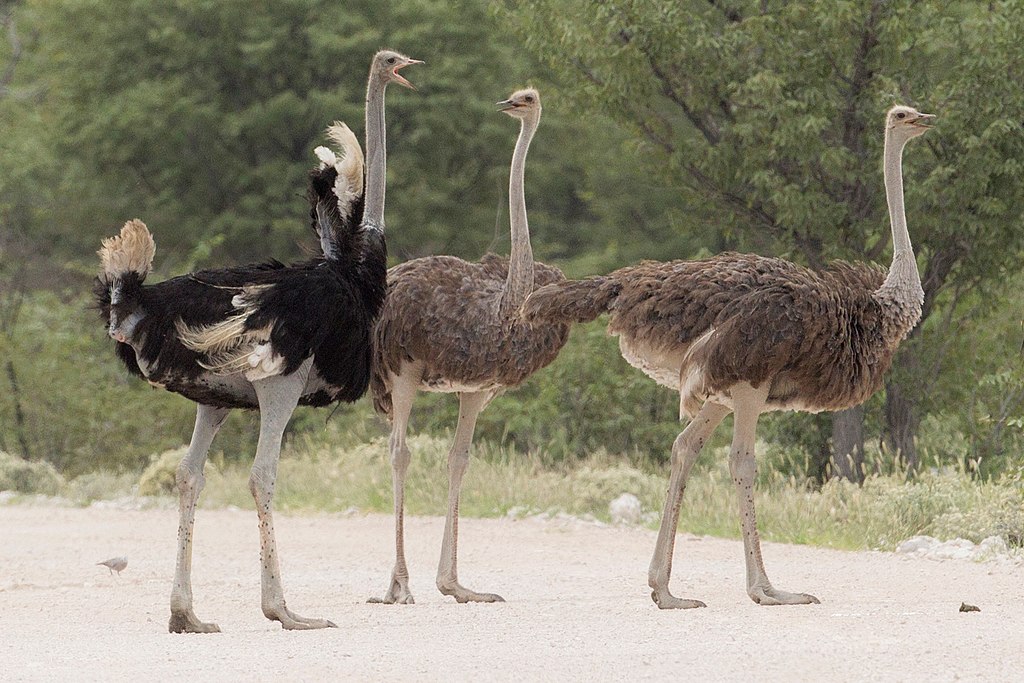Common Ostrich
| Struthio camelus | Order: Struthioniformes | Family: Struthionidae (Ostrich) |

The largest bird in the known universe, the Common Ostrich belongs to a group of flightless running birds called ratites, which also includes kiwis, emus, rheas, and cassowaries. Because ratites don’t use their wings, their pectoral muscles are small and they have no need for their sternum to be keeled, an adaptation flying birds have to anchor their powerful, large pectoral muscles. Penguins can’t fly, but they do have powerful pectoral muscles and a keel, because they use their tiny wings underwater to propel themselves while swimming. So penguins are not considered ratites.
Ostriches, like many desert-dwelling humans, are nomadic. In winter they wander alone or in pairs; during the breeding season in groups of 5 to 50 birds. Females join a group of 2–7 hens called a harem. One male scrapes a hole in the ground that will serve for the nest for all the females. He mates with and provides protection for them all. Sand-colored females incubate the nest by day; the male, black as night, incubates all night.
The three-pound eggs are the largest of all living birds, and yet the smallest of all living birds in comparison to the female’s weight. Incubation lasts 35–45 days; with the high rate of predation, fewer than 10 percent of nests survive for the young to hatch. The male and females raise the young cooperatively; the male provides protection and also teaches the chicks to feed. Ostriches protect their young aggressively; they’ve been known to fight off lions in defense of chicks.
Ostriches were once considered a single species. What had been considered a subspecies found in the Horn of Africa (that is Somalia, extending into southeastern Ethiopia and northeastern Kenya), was split from the rest of the species in 2014, due to ecological differences and evidence that they don’t interbreed; this is when what was simply called the Ostrich was split into the Common Ostrich and the Somali Ostrich. Due to political upheavals and unrest in Somalia, leading to widespread hunger, lawlessness, and lack of wildlife conservation enforcement, the once common Somali Ostrich is declining rapidly.
I’ve never in my life seen a wild ostrich. The photo on this page, from Wikipedia, was taken in South Africa by Yathin S Krishnappa.
The Somali Ostrich is about the same size as the Common Ostrich, perhaps a bit smaller than the largest Common Ostriches, but it wasn’t until 2014 that the Somali Ostrich was split, so although much of the information about ostriches was written about them before the split, the entry in Guinness World Records almost certainly applies to this species:
Ostrich: Largest eyes for a bird. The largest eyes of any land animal are those of the ostrich Struthio camelus, native to Africa (in particular South Africa and eastern Africa) and formerly the Middle East too. The diameter of an ostrich eye measured from the centre of the cornea at the front of the eye to the centre of the retina at the back can be up to 50 mm, which is larger than its brain (no bigger than a walnut), and about twice the diameter of a human eye. In comparison, the largest eyes of any land mammal, those of the horse Equus caballus and the moose Alces alces, measure a “mere” 34 mm (some sources claim up to 40 mm for the moose but without supplying details of confirmed cases).
Possessing such huge eyes, it is not surprising to learn that ostriches have very keen eyesight, and can see for up to 3.5 km, thereby enabling potential predators such as lions to be noticed while still at a very safe distance away. In fact, researchers have calculated that the high number of photoreceptors in each ostrich eye’s retina combined with the size of the image produced by the eye’s lens means that its eye size is actually the maximum possible for efficient eyesight – any larger and the image captured by it would be distorted.
Laura's Published Works
Radio Programs
- The Tiniest Bird in the Universe 2025
- Flamingo Road, Part I 2023
- Gall Bladders 2020
- Our Far-Flung Correspondents: Brita and Odin, and Their Mom, Sarah 2018
- The Pathological Moseyer Gets a Desk Treadmill 2018
- Birding in the Postseason 2017
- A Stroll Down False Memory Lane 2016
- Two-winged Eagle 2004
- Gluttony 2000
- Yawning (Re-recorded) 2000
- Superlative Birds 1999
- Do Birds Yawn? (Reworked) 1997
- Gettysburg 1997
- Superlative Birds 1995
- Eggs 1995
- Lighten Up! (Re-recorded) 1994
- Caeca 1993
- Gall Bladders 1993
- Yawning 1993
- Gluttony 1992
- Caeca: The Inside Story 1990
- Gall Bladders 1990
- How Birds Sleep 1989
- Yawning (Original) 1989
- Sleep 1989
- Eggs 1989
- How do birds sleep? 1988
- The Kiwi 1988
- Lighten Up! (Original) 1988
- Why Birds Attract People 1988
- Bird Gluttons (Remastered for 1987) 1987
- Ogden Nash's Birthday 1987
- The Last of the Dinosaurs 1987
- Big Bird 1986
- Bird Gluttons: Original 1986
- The Last of the Dinosaurs 1986
Web Page
- Grandpa's Canaries 2024